|
First, the
primer --


THE
BUILDING BLOCKS OF PERSONALITY
What
defines personality? Do you know? If you had to break personality
down to analyze its underlying structure, what
regulating principles could you identify? Got any idea? (It helps if
you actually think about that for a moment before you continue reading.)
Carl Jung
said personality is based on two things:
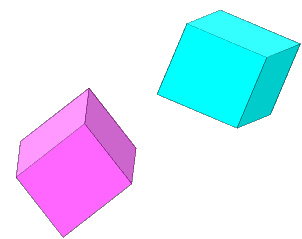
how we
take in information
and
how we
make decisions
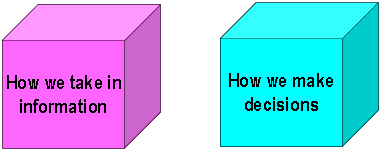
According
to Carl, these are the two core elements that create personality. Not
yellow bile and phlegm, or your sexual drive, or whether your mother made you
eat spinach. What he defined was much more universal than that.
He took the
first element, "how we take in information," and labeled it with the
moniker "Perceiving." He took the second element, "how
we make decisions," and labeled it with the moniker
"Judging." (We can question the wisdom of choosing these
particular labels, but they are the names he left us with.)
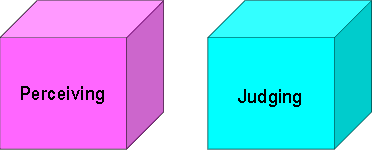
Professor
Jung further decided that we have two primary ways of taking in information, and we
prefer one way over the other (although everybody does both!). He called
these ways of perceiving Sensing and Intuiting --

| Sensing
concerns itself with: |
Intuition
concerns itself with: |
-
What is real; concrete
-
Practical
-
Utility
-
Step by
step
-
5 senses (sight, sound, taste, touch,
smell) & balance
-
What
can be measured & documented
|
-
Future possibilities; abstract
-
Theoretical
-
Novelty
-
“Sixth
Sense”
-
Ideas, patterns, possibilities, hypotheses, inferred meanings
|
Then Jung
looked at the Judging function, and determined that we have
two primary ways of making decisions, and we prefer one way over the other (although everybody does
both!). He called these Thinking and Feeling (these labels may have been unfortunate
choices -- especially as it's important to note that Feeling as a
function is not emotions per se).

| Thinking
concerns itself with: |
Feeling
concerns itself with: |
-
Logic
-
Logical systems
-
Head
-
Objective
-
Critique
-
Principles
-
Reason
-
Impersonal
-
Black and white
|
-
Personal values
-
Value system
-
Heart
-
Subjective
-
Compliments
-
Harmony
-
Empathy
-
Shades of gray
|
You'd think
that would be good and complex enough to satisfy anybody, right? But no,
Carl Jung had to take it one step further. Each of these four processes (Sensing,
iNtuiting, Thinking, Feeling) can be expressed internally OR
externally. They can happen inside of you or outside of you.
Inner World
/ Outer World
The two
processes of Perceiving (Sensing, iNtuiting) expand to four, multiplied
by whether the operation happens internally or externally. The internal
operations are called introverted, and the external operations are called
extraverted. Altogether, there are 4 different flavors of
Perceiving.
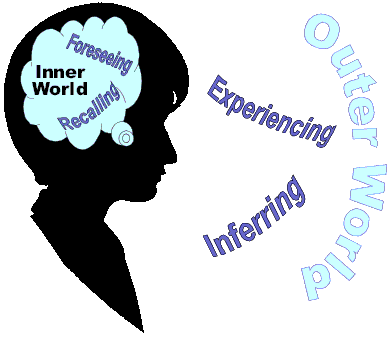
Where would
modern technology be without abbreviations and acronyms? So, too, Type has a set of acronyms that
must be grasped.
Extraverted
functions are indicated by an “e” suffix
Note: the
letter “N” stands for “iNtuition” to avoid any confusion with “i” for “introverting.”
Introverted
functions are indicated by an “i” suffix
Note:
defining whether a function is introverted or extraverted is called
"attitude." Thus, Si is shorthand for Sensing in the
"introverted attitude." Let
me show you how this manifests in the model. First, Sensing breaks
into its two attitudes:
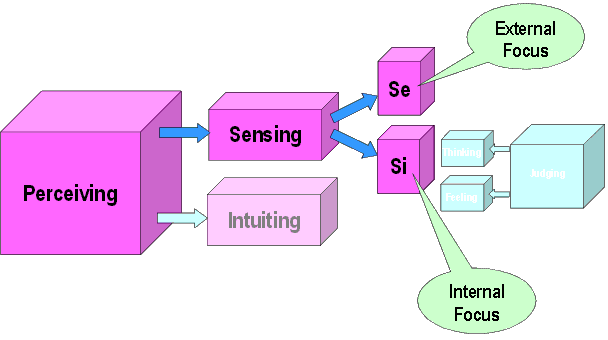
followed by
iNtuiting in its two attitudes:
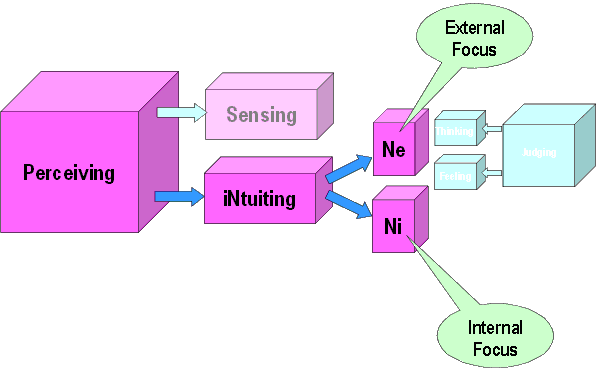
Now
Judging
The two
processes of Judging (Feeling, Thinking) also expand to four,
multiplied by whether the operation happens internally or externally.
Altogether, there are 4 different flavors of Judging.
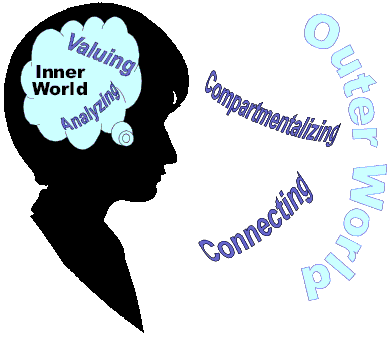
Extraverted
functions are again indicated by that “e” suffix
Introverted
functions are again indicated by an “i” suffix
It's time
to show you how this manifests in the model. First, Thinking
breaks into its two attitudes:
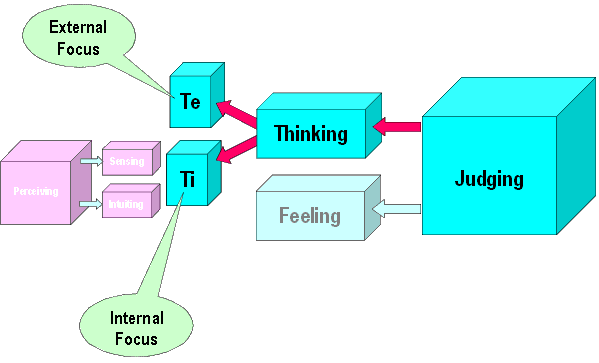
followed by
Feeling in its two attitudes:
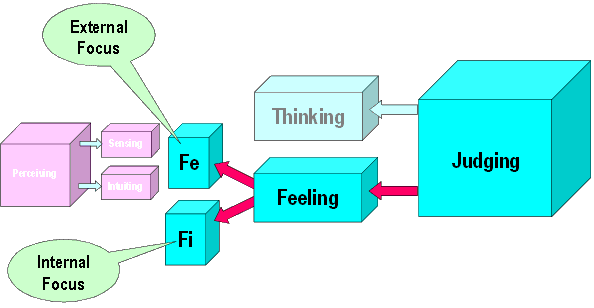
When we put it all together, here's the
whole picture with all eight functions displayed --
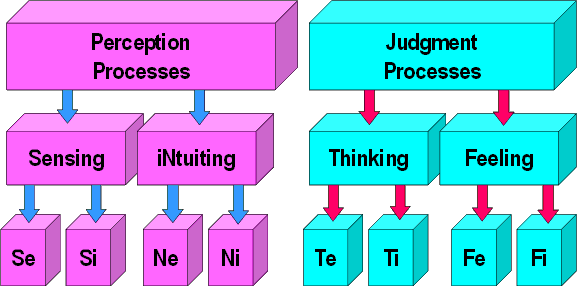
TA DAAAA
!!
Now doesn't
that just explain everything!?! When Socrates said, "Know
thyself," I've no doubt this is what he had in mind. You should feel
lots better about yourself now! Congratulations!
Umm,
other
factors affect personality of course --
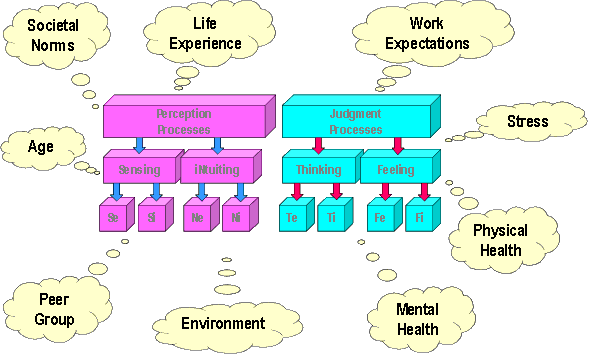
...but those
aren't building blocks per se, so we'll dispense with analyzing those influences
for the time being.
To
summarize then,
we have by now identified and formulated the 8 building blocks that make up
anybody's personality. Click here
to read brief descriptions of all eight of the functions and grasp the detail of
what they concern themselves with.
Something
important to note is that these building blocks are processes, not
traits. It's incorrect to say someone is iNtuitive
[noun]. It's correct to say someone is iNtuiting [verb], or using
their iNtuition. The same goes for all of the functions -- they should
have an ing suffix at the end if they are being used properly. And remember, all of
us can and DO utilize all eight of these functions -- none of us got overlooked and
missed out on one or two of them.
This is a
very complex topic, and you could devote your life to understanding it
(some of us do!). I highly recommend reading more in order to
gain a fuller understanding of how this stuff works, especially so you don't fall into
the habit of associating "traits" with the functions and attempt to
turn Type
into a trait-based personality model instead of the pattern-based model it was
intended to be.
For an inexpensive
and targeted guide to the type code and the function using this approach,
this booklet is the best available:

Understanding Yourself and
Others
An Introduction to the Personality Type Code
by Dr. Linda Berens & Dr. Dario Nardi
It is also
the only book containing type descriptions that describe all eight functions
within the individual personality.
I
also have a CD available on the subject:

Type
Insights: The 8-Level
Model of Psychological Types
by Vicky Jo Varner
Your next
mission, after grasping what these functions do, is to rank all eight from your most
favorite to least favorite. That becomes your order of preference.
(That's why we call our type code preferences, and it's the way we get to 16 type patterns altogether.)
Research has established that INFJ types have a preferred hierarchy for using
the 8 Cognitive Processes as shown below.
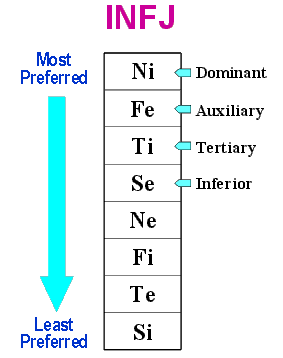
Here's
more terminology for you: Dominant, Auxiliary, Tertiary, Inferior.
They're fairly self-evident -- dominant is your favorite, auxiliary is the
second, the term tertiary is Greek for third, and inferior is the 4th
function.
Now let's
"unpack" this code for you.
INFJs
use Ni in the inner world, and
it manifests through their dominant process:
Introverted iNtuition (Ni)
"This is how it will be."
"Aha, that's it!"
When Ni is a preferred process...
-
You usually feel a certainty about what is going to happen, often
without much detail and without being able to trace the actual data
that would support the prediction.
-
You focus on "what will be."
-
You are energized by transformational visions of how someone can
grow or of a completely original approach to get there.
-
You are drawn to make those visions manifest.
-
Frequently you experience flashes of insight that present
themselves as very broad themes and complex whole patterns or
systems of thought without being triggered by external events.
-
Inner images come as a knowing that taps into universal symbols
and with a certainty that they are true.
INFJs
use Fe in the outer world, and
it manifests through their auxiliary process:
Extraverted Feeling (Fe)
"This is what we need."
"We do . . ."
When Fe is a preferred process...
-
You give attention to creating and maintaining harmonious
relationships, often using social convention to keep harmony, to
make people feel comfortable and included, and to keep the group
intact.
-
Often you are at ease with social conversations and knowing just
the right words to say to someone.
-
You easily disclose personal details to encourage others to
express themselves.
-
You place importance on making space for the expression of
feelings -- positive and negative.
-
You organize time, space, and thing in relation to the effects on
people.
-
You often feel pulled to take care of everyone or even whole
groups, either physically or emotionally. Meeting the needs of
others is energizing until your own needs are ignored for too long.
INFJs
use Ti in the inner world, and
it manifests through their auxiliary process. (This process tends to
oscillate -- inflating and deflating -- so it can be larger than life one
moment and then the lowest of the low.)
Note: some people
dispute the attitude of the third function -- the school I'm associated
with teaches that the attitudes alternate in an ongoing balancing act.
Introverted
Thinking (Ti)
"This is
why . . ."
"It does . . ."
When Ti is a preferred process...
-
Identifying,
naming, and classifying are second nature and almost impossible to
avoid.
-
Often
a refined categorizing scheme is used that is not necessarily made
public until something doesn't fit and then inconsistencies will be
quickly pointed out.
-
Delineating
categories and articulating principles can be as energizing as
analyzing and critiquing what is wrong with something.
-
There
is a tendency to stay in a mode of detached analysis while getting
at the root of things for effective problem solving.
-
You
focus on finding just the right way to say something, often
reporting only the essential characteristics rather than explanatory
detail.
-
If
something doesn't fit the existing framework, you either reject it
or thoroughly take it apart to see how it works. Sometimes the
whole framework may have to be revised.
INFJs
use Se in the outer world, and
it manifests through their inferior process.
Note:
the term inferior describes the 4th function when common sense would lead one to
believe it would describe the 8th. Inferior is another unfortunate
choice of terms, because it implies that we somehow can't use it. In
truth, we don't use it well. In light of that understanding, only
some of the following description will probably resonate with you -- but not
all.
Extraverted
Sensing (Se)
"This
is what is."
"What's next?"
When Se
is a preferred process...
-
You
fully experience the immediate context to the point of "oneness"
with whatever is going on.
-
You get
energized when every in touch with the tangible environment and able to
express yourself physically.
-
"What
is" is appreciated for what it is and nothing beyond that.
-
You
have very keen senses, intensifying rich sensory details and liking lots of
stimulation and variety in activity.
-
You
focus on facts and ask lots of questions when you're not getting a clear
picture.
-
You pay
attention and respond quickly to the rapidly shifting information in a
random and constantly changing scene, attending to what is most relevant at
the time, and ignoring the rest.
*
So that's a brief breakdown of the top four favored functions for an INFJ. (I won't
bother with the remaining four, although you do use them and they do show up in
your personality. The Archetypes model will
say more about them.)
If the functions you favor
don't match this picture, perhaps you'd best go back and
clarify your choice further...
~ ~ ~
You know
these materials are copyright, right?
* * *
| ![]()
![]()